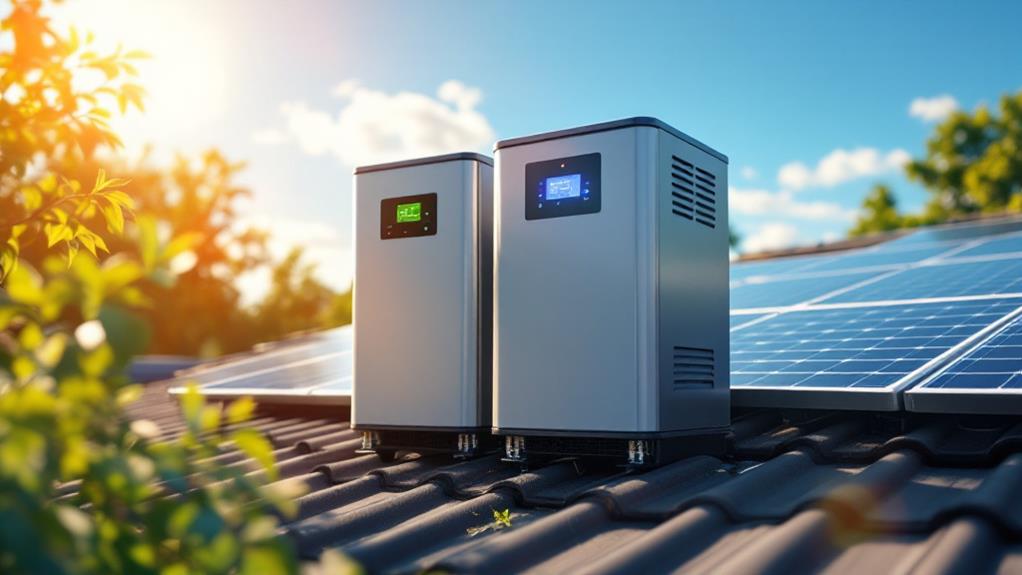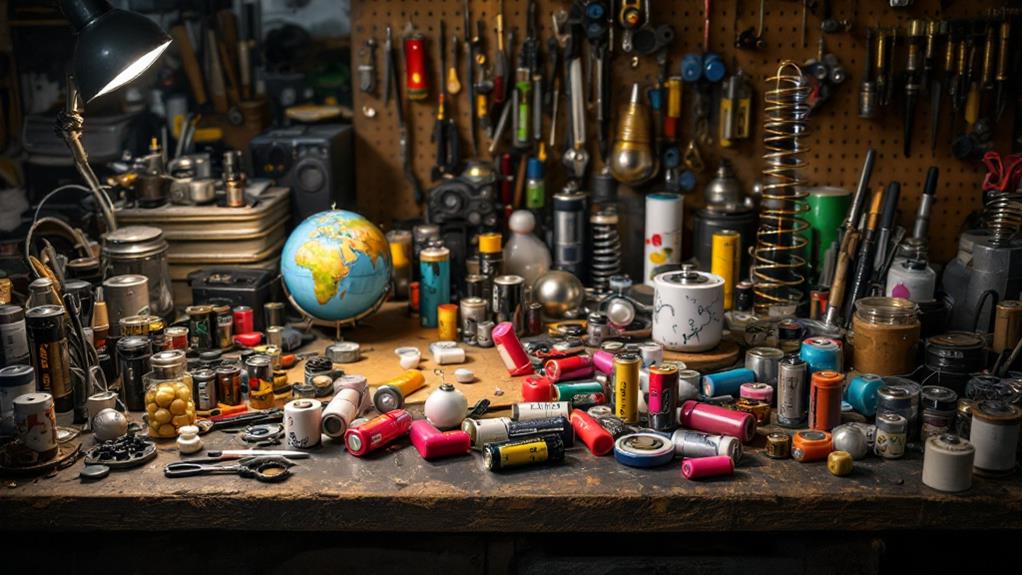Tips for Finding and Eliminating Household Energy Vampires: Save on Your Energy Bill
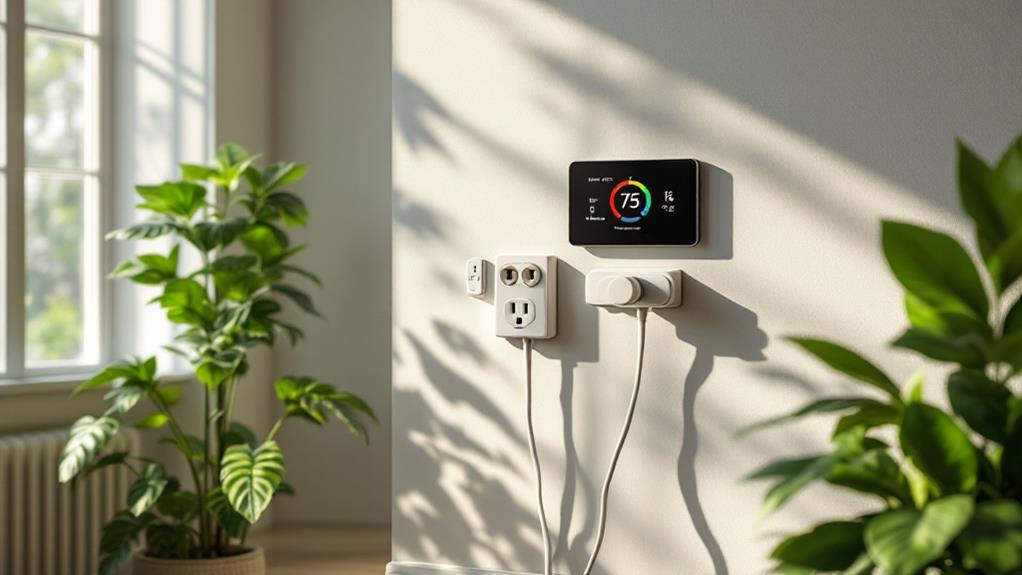
To find and eliminate energy vampires in your home, start by identifying common culprits like kitchen appliances, entertainment systems, and home office devices. Unplug rarely used items with LED lights or digital displays, and use smart power strips to cut off electricity to multiple devices at once. Replace older appliances with ENERGY STAR certified models, and adjust your smartphone and laptop charging habits. Don't forget to check for hidden power drains like doorbell transformers or security systems. Conduct a home energy audit to pinpoint areas for improvement. By taking these steps, you'll see a noticeable reduction in your energy bill. Uncover even more ways to outsmart these silent energy thieves.
Understanding Energy Vampires
Three key aspects define energy vampires in your home. First, they're devices that continue to draw power even when turned off or in standby mode. Second, they're often overlooked, contributing to invisible energy usage that can profoundly impact your electricity bill. Third, they're found in nearly every room, making them pervasive and challenging to identify without careful inspection.
Common energy vampires include chargers left plugged in, electronics with standby lights, and appliances with digital displays. These devices may seem harmless, but their cumulative effect can account for up to 10% of your home's energy consumption. To combat this drain, start by monitoring energy consumption with a smart meter or plug-in energy monitor. These tools help you identify which devices are drawing power unnecessively.
Once you've pinpointed the culprits, take action. Unplug devices when not in use, use power strips to easily cut off multiple vampires at once, and opt for Energy Star-certified products that consume less standby power. By understanding and addressing energy vampires, you'll reduce your carbon footprint and save money on your energy bills.
Common Household Culprits
Surprisingly, some of the most common energy vampires lurk in unexpected places throughout your home. These typical power hogs can silently drain your electricity and inflate your energy bills. To combat these overlooked energy sources, you'll need to identify and address them systematically.
Your kitchen is a hotspot for energy vampires. Appliances like coffee makers, toasters, and microwaves continue to draw power even when not in use. In your living room, entertainment systems, including TVs, gaming consoles, and cable boxes, are notorious for their standby power consumption. Don't forget about your home office, where computers, printers, and charging stations can be significant energy drains.
To tackle these common culprits, consider the following steps:
- Use power strips to easily cut off electricity to multiple devices at once
- Unplug small appliances when not in use, especially those with digital displays
- Enable power-saving modes on electronics and adjust screen brightness
Identifying Hidden Power Drains
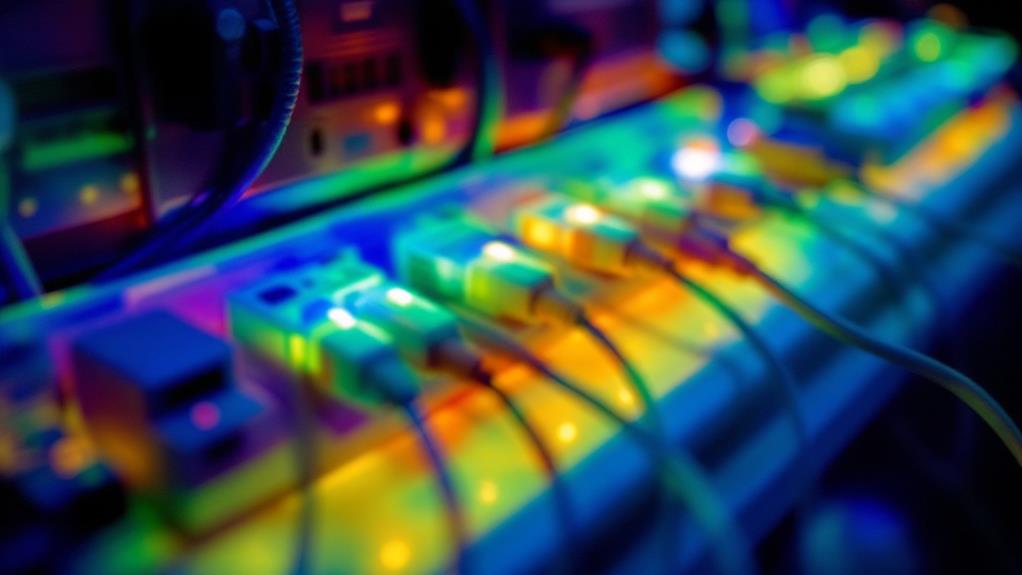
Hidden power drains can be trickier to spot than their more obvious counterparts. These sneaky energy consumers, also known as phantom loads, quietly alter electricity even when you think they're turned off. To identify these culprits, start by unplugging devices you rarely use. Pay attention to items with LED lights, digital displays, or remote controls, as they often draw power continuously.
Look for warm power adapters or chargers when devices aren't in use – this indicates ongoing energy consumption. Check your entertainment center, home office, and kitchen for potential offenders. Many modern appliances and electronics have standby modes that silently drain power.
To pinpoint hidden energy vampires more accurately, consider using energy monitoring devices. These tools can measure the electricity usage of individual outlets or your entire home, helping you identify unexpected power draws. Some smart home systems even offer integrated energy monitoring features.
Don't overlook less obvious sources like doorbell transformers, security systems, or pool pumps. By systematically investigating your home's energy use, you'll uncover hidden power drains and take the first step toward reducing your energy consumption and lowering your utility bills.
Smart Power Strips
Once you've identified the energy vampires in your home, smart power strips offer an effective solution to combat them. These devices automatically cut power to electronics when they're not in use, preventing standby power consumption. By integrating smart power strips into your smart home automation system, you can considerably reduce your energy consumption and lower your utility bills.
Smart power strips come with various features to enhance their functionality:
- Occupancy sensors that detect when you're in the room and power on devices accordingly
- Scheduled on/off times to align with your daily routines
- Remote control capabilities through smartphone apps for convenient management
When incorporating smart power strips into your smart device usage, consider placing them in areas with multiple electronics, such as entertainment centers or home offices. You can program them to turn off non-essential devices during nighttime hours or when you're away from home. Some advanced models even monitor energy consumption and provide detailed reports, helping you identify which devices are the biggest energy drains. By leveraging these features, you'll take a substantial step towards creating a more energy-efficient home and reducing your carbon footprint.
Unplugging Unused Devices
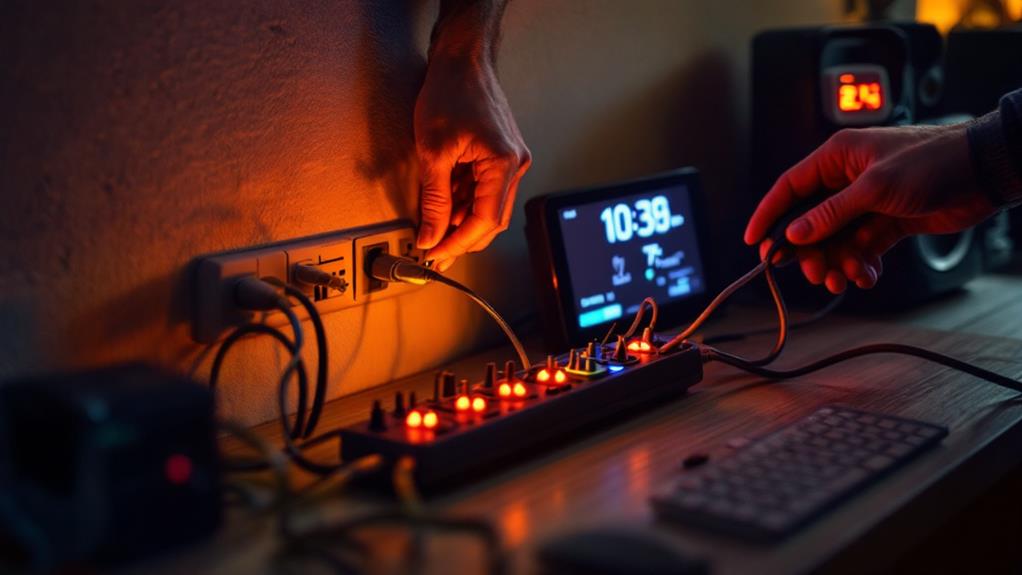
The humble power cord holds more significance than you might think. When you leave devices plugged in, even if they're turned off, they continue to draw power. This phantom power consumption can add up, silently inflating your energy bill.
To combat this, make it a habit to unplug devices when they're not in use. Focus on items that aren't frequently used, such as guest room TVs, spare computers, or rarely-used kitchen appliances. Don't forget about chargers for phones, tablets, and laptops – they draw power even when not connected to a device.
For items that are difficult to unplug regularly, consider using power strips with on/off switches. This allows you to cut power to multiple devices with a single action. Pay special attention to entertainment centers and home office setups, where numerous devices cluster together.
Be mindful of devices with battery backup systems, like cordless phones or security systems. These need to remain plugged in, but you can still reduce their energy consumption by choosing energy-efficient models when it's time for an upgrade.
Energy-Efficient Appliance Upgrades
In light of the ongoing battle against energy vampires, upgrading to energy-efficient appliances stands out as a powerful strategy. By replacing older, energy-hungry devices with modern, efficient alternatives, you'll drastically reduce your home's energy consumption and lower your utility bills.
When considering energy-efficient appliance upgrades, focus on the biggest energy consumers in your home:
- HVAC systems: Invest in home heating upgrades like high-efficiency furnaces or heat pumps to slash your heating and cooling costs.
- Water heaters: Choose tankless or heat pump water heaters for substantial energy savings.
- Refrigerators and freezers: Opt for ENERGY STAR certified models that use up to 15% less energy than standard units.
Don't overlook efficient lighting options as part of your upgrade strategy. LED bulbs use up to 75% less energy than traditional incandescent bulbs and last much longer. Replace your old light fixtures with LED-compatible options to maximize energy savings and improve your home's lighting quality.
Remember to look for the ENERGY STAR label when shopping for new appliances. These certified products meet strict energy efficiency guidelines set by the U.S. Environmental Protection Agency and the Department of Energy, ensuring you're making a smart, energy-saving choice.
Smartphone and Laptop Charging Habits
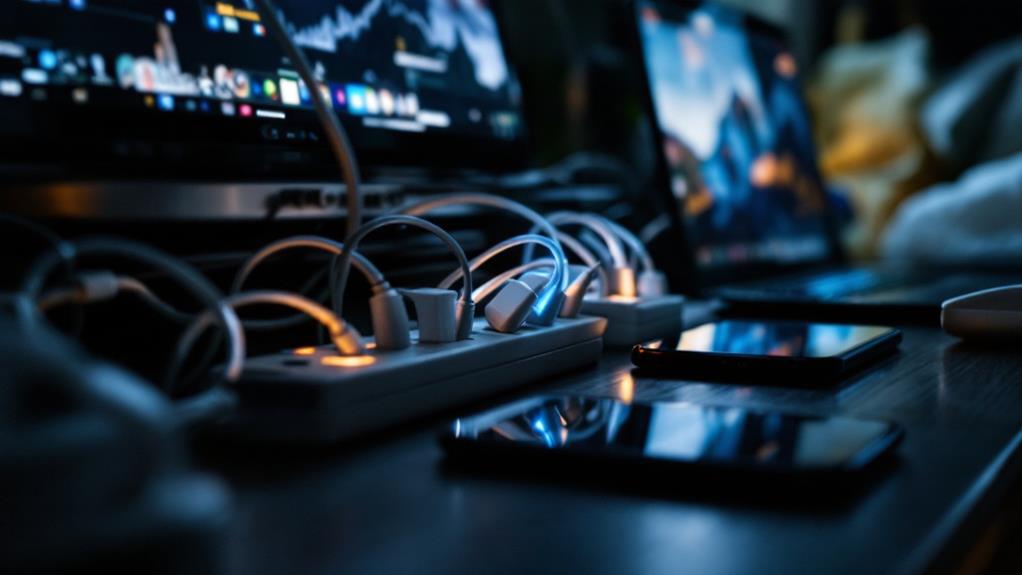
While upgrading appliances can greatly reduce energy consumption, don't overlook the impact of your daily charging habits. Your smartphones and laptops, though small, can contribute significantly to your energy bill if not managed properly. To practice energy efficient charging habits, start by unplugging chargers when not in use. These devices continue to draw power even when not connected to your gadgets.
Implement battery life optimization techniques to reduce charging frequency. Adjust your screen brightness, turn off unnecessary notifications, and close unused apps. When charging, avoid leaving your devices plugged in overnight or for extended periods after reaching full capacity. This not only wastes energy but can also degrade your battery's longevity.
Consider using smart power strips that automatically cut power to devices when they're fully charged or not in use. When possible, charge your devices during off-peak hours when electricity rates are lower. Finally, invest in high-quality, energy-efficient chargers that meet your devices' specific requirements. By adopting these practices, you'll reduce your energy consumption and extend the lifespan of your devices, saving both money and resources in the long run.
Standby Mode vs. Power Off
Considering the energy-saving potential, it is critical to understand the difference between standby mode and powering off your devices. Standby mode, also known as idle mode, keeps your electronics in a low-power state, ready to quickly resume operation. However, this convenience comes at a cost, as devices in standby still draw electricity. On the other hand, powering off completely cuts the energy flow, saving you more money on your utility bills.
To maximize energy efficiency, consider these strategies:
- Leverage automatic power down settings on your devices to guarantee they don't remain in standby mode unnecessarily.
- Invest in smart power strips that detect when devices are in standby and cut off power completely.
- Create a nightly routine of manually unplugging or switching off non-essential electronics.
Home Energy Audit Tips
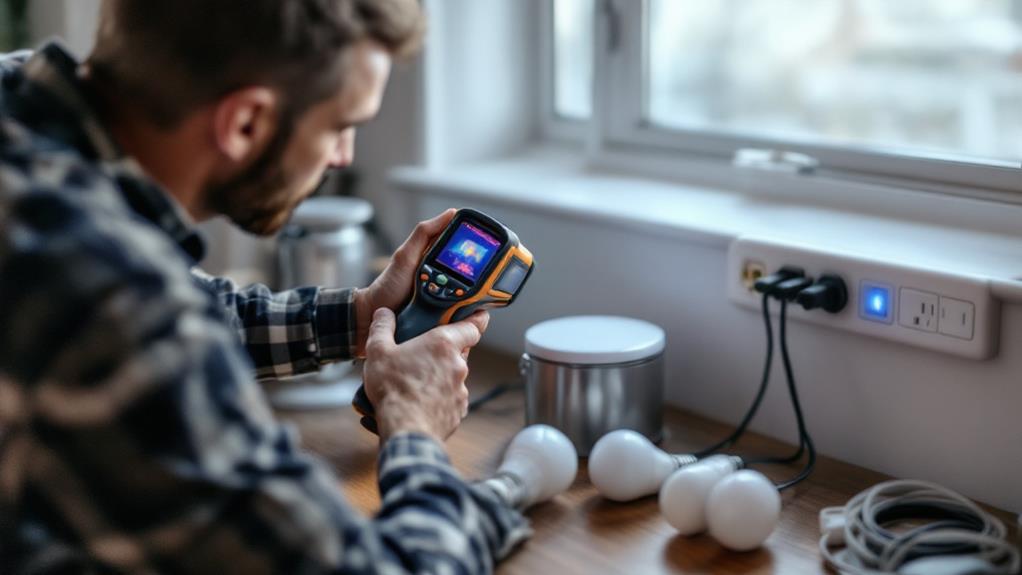
To effectively tackle energy vampires in your home, conducting a thorough energy audit is essential. Start by walking through each room with a checklist, identifying all electronic devices and appliances. Note which ones are constantly plugged in, even when not in use. Pay special attention to areas with multiple devices, like entertainment centers or home offices.
Next, use a power meter to measure the energy consumption of suspicious devices. This tool will help you pinpoint the biggest culprits. Don't forget to check less obvious sources, such as chargers left plugged in without devices attached.
While focusing on energy vampires, take this opportunity to assess your home's overall energy efficiency. Look for drafts around windows and doors, which may indicate the need for energy efficient windows or better weatherstripping. Check your attic and walls for adequate insulation; insulation upgrades can drastically reduce energy waste.
Consider scheduling a professional energy audit for a more comprehensive assessment. They can use specialized equipment like infrared cameras to detect hidden energy leaks and provide customized recommendations for improvements, potentially uncovering energy vampires you might have missed on your own.
